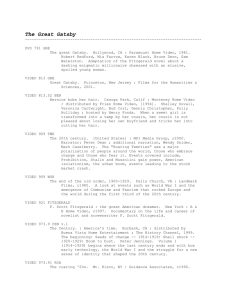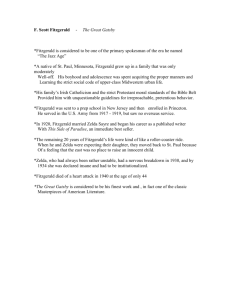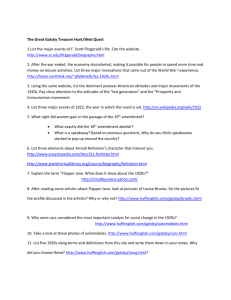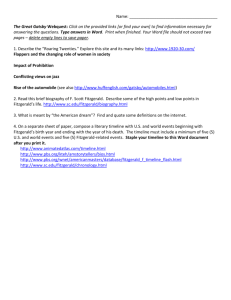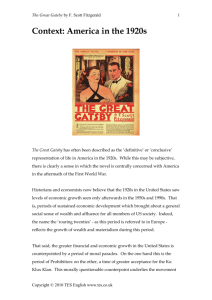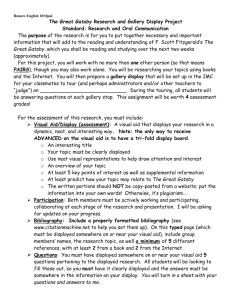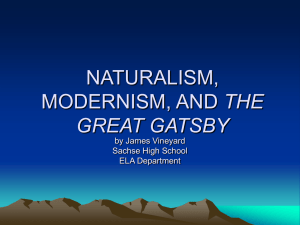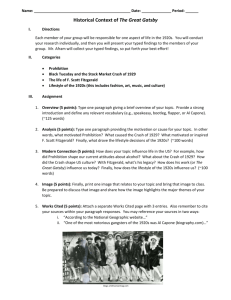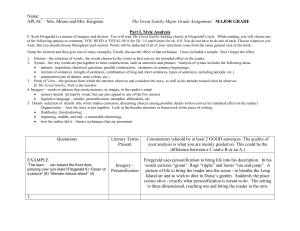Fitzgerald AND HIS GREAT GATSBY
advertisement
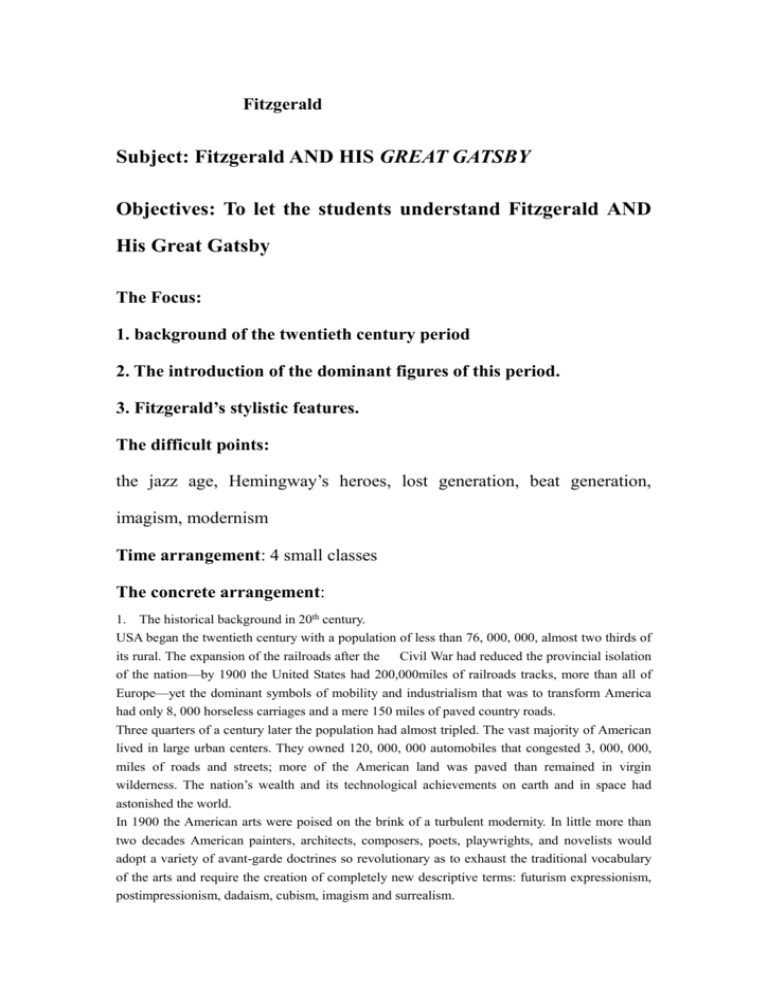
Fitzgerald Subject: Fitzgerald AND HIS GREAT GATSBY Objectives: To let the students understand Fitzgerald AND His Great Gatsby The Focus: 1. background of the twentieth century period 2. The introduction of the dominant figures of this period. 3. Fitzgerald’s stylistic features. The difficult points: the jazz age, Hemingway’s heroes, lost generation, beat generation, imagism, modernism Time arrangement: 4 small classes The concrete arrangement: 1. The historical background in 20th century. USA began the twentieth century with a population of less than 76, 000, 000, almost two thirds of its rural. The expansion of the railroads after the Civil War had reduced the provincial isolation of the nation—by 1900 the United States had 200,000miles of railroads tracks, more than all of Europe—yet the dominant symbols of mobility and industrialism that was to transform America had only 8, 000 horseless carriages and a mere 150 miles of paved country roads. Three quarters of a century later the population had almost tripled. The vast majority of American lived in large urban centers. They owned 120, 000, 000 automobiles that congested 3, 000, 000, miles of roads and streets; more of the American land was paved than remained in virgin wilderness. The nation’s wealth and its technological achievements on earth and in space had astonished the world. In 1900 the American arts were poised on the brink of a turbulent modernity. In little more than two decades American painters, architects, composers, poets, playwrights, and novelists would adopt a variety of avant-garde doctrines so revolutionary as to exhaust the traditional vocabulary of the arts and require the creation of completely new descriptive terms: futurism expressionism, postimpressionism, dadaism, cubism, imagism and surrealism. In the years preceding World War I, nineteenth-century realism and naturalism remained vital forces in American literature. The growth of mass-circulation periodicals created a rich marketplace for popular writers. By the 1920s general audience magazines with circulation in the millions were paying as much as six thousand dollars for a short story and sixty thousand dollars for a serial. During the depression years of the 1930s the profitable mass market for literature temporarily declined, but after World War II it expanded enormously with the growth of the population, the increase of wealth and education, the expansion of mass distribution book clubs, and the technological advances in printing that made possible the publishing of vast numbers of inexpensive paperbacks. Early in the century a rising number of “little magazines” brought numerous avant-garde writers to the attention of a limited but sophisticated audience. The most influential was Poetry, their works often forced changes in the traditional relationships between poets and their audience, requiring readers armed with modernist sympathies and advanced intellectual understanding. Although the form and direction of modern American literature had clearly begun to emerge in the first decades of the century, the first world war stands as a great dividing line between the nineteenth century and contemporary America. World War I had its origins in the political turmoil of the early 1900s and in the vain rivalries of imperial powers that once had seemed to be the glory of their age. For the USA the war began as a crusade for purity and democracy, and at its end, President Woodrow Wilson proclaimed that Americans had gained everything for which they had fought. But out of the war’s catastrophes and appalling waste came little more than a sense of the failure of political leaders and a belief in the futility of hope; no abiding solutions to the world’s problems had been found, and the years following the war soon brought the resurgence of nationalism and the rise of new totalitarianism that would in turn produce a second world war less than a quarter of a century later. Writers of the first postwar era self-consciously acknowledged that they were a “lost generation”, devoid of faith and alienated from a civilization. Yet in the decade of the 1920s American literature achieved a new diversity and reached its greatest heights. The publication in 1922 of T. S. Eliot’s the Waste Land, the most significant American poem of the 20th century, helped to establish a modern tradition of literature rich with learning and allusive thought. After the first World war a group of new American dramatists emerged, and the American theater ceased to be wholly dependent on the dramatic traditions of Europe. Experimental playwrights, hostile to outworn and timid theatrical convention, created works of tragedy, stark realism, and social protest. In the “new American theatre” plots, dialogue, staging, and acting differed radically from the bland dramatic fare of an earlier day. The years between 1920 and 1930 were a time of new directions and new achievements in all the arts. Numerous museums and galleries for modern art were established. the American skyscraper became the pre-eminent achievement of 20th century architecture. The American motion picture industry rose to world dominance. Jazz music of the American Negro—the most influential art form to originate in the USA spread throughout the world. And with the slow disintegration of old prejudices came the “Harlem Renaissance”, a burst of literary achievement in the 1920s by Negro playwrights, poets, and novelists who presented new insights into the American experience and prepared the way for the emergence of numerous black writers after mid-century. With the end of the decade came the stock market crash of 1929 and the great depression of the 1930s, cataclysmic events that shattered public complacency and transformed American society. The abrupt end of prosperity weakened the nation’s confidence in its government and its political leaders. American artists of all kinds produced works of political and social criticism. Painters created harsh visions of American life on farms and in cities. Photographers recorded the miseries of poverty and want. The social unheavals and the literary concerns of the Great Depression years ended with the prosperity and turmoil brought by the Second World War. After the war a new generation of American authors appeared, writing in the skeptical, ironic tradition of the earlier realists and naturalists. The writers of the fifties used a prose style modeled on the works of Ernest Hemingway and F. Scott Fitzgerald, narrative techniques derived from William Faulkner, and psychological insights taken from the writing of Sigmund Freud and his followers. In the 1960s and 1970s America’s prose writers turned increasingly to experimental techniques, to absurd humor, and to mocking examination of the irrational and the disordered. 2. writer F. Scott Fitzgerald and his features. 2.1. the introduction of the writer. (omission ) 2.2. Fitzgerald was one of the great stylists in American literature. T. S. Eliot read the Great Gatsby three times and concluded that it was “the first step that American fiction has taken since Henry James” Fitzgerald’s prose is smooth, sensitive and completely original in its diction and metaphors. Its simplicity and gracefulness, its skill in manipulating the relation between the general and the specific, its bold impressionistic and colorful quality, in short, its competence to convey the vision of the author all reveal Fitzgerald’s consummate artistic. 2.3. now Gatsby’s life follows a clear pattern: there is, at first, a dream, then a disenchantment, and finally a sense of failure and despair. In this, Gatsby’s personal experience approximates the whole of the American experience up to the first few decades of this century. America had been “a fresh, green breast of the new world,” had “pandered to the last and greatest of all human dreams” and promised something like “the orgiastic future” for humanity. Now the virgin forests have vanished and made way for a modern civilization, the only fitting symbols of which is the “valley of ashes”, the living hell. Here modern men live in sterility and meaninglessness and futility as best illustrated by Gatsby’s essentially pointless parties. The crowds hardly know their host; many come and go without invitation. The music , the laughter, and the faces, all blurred as one confused mass, signify the purposelessness and loneliness of the party-goers beneath their masks of relaxation and joviality. The shallowness of Daisy whose voice is “full of money”, the restless wickedness of Tom, the representative of the egocentric, careless rich, and Gatsby who is, on the one hand, charmingly innocent enough to believe that the past can be recovered and resurrected, but is on the other hand, both corrupt and corrupting, tragically convinced of the power of money, however it was made the behavior of these and other people like the Wilsons all clearly denote the vanishing of the great expectations which the first settlement of the American continent had inspired. The hope is gone; despair and doom have set in. thus Gatsby’s personal life has assumed a magnitude as a “cultural—historical allegory” for the nation. Here, then, lies the greatest intellectual achievement that Fitzgerald ever achieved.
